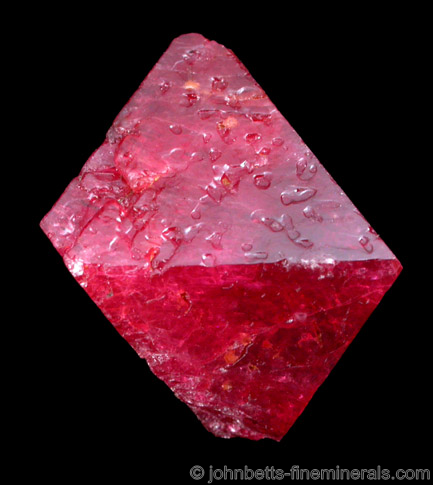The spinel Mineral Series

Spinel occurs in almost every color, and forms gems of all
colors. It is not a well known gem, although good specimens can attain very high prices. Bright red Spinel, known as Ruby Spinel, is the most
valuable Spinel. In the past, there was no distinction between true Ruby
and Ruby Spinel, as they look very similar and are found together in the same
localities. (Nowadays, distinctions can be easily made through hardness and
x-ray tests.) Many famous old "Rubies" were found to actually be Spinel. The
famous Black Prince's Ruby that forms the centerpiece of the royal crown of Great
Britain was discovered to be a
Spinel rather then a Ruby.
Magnesium Spinel, often just known plainly as Spinel, is the most common and well-known member of the Spinel series. Gahnite is also known among collectors, while the other two members (Hercynite and Galaxite) are very rare and seldom represented in collections.
For additional information, see the gemstone section on Spinel.
Chemical Formula
MgAl2O4
The Mg may be partially or fully replaced by Fe, Zn, and/or Mn. This leads to a mineral series with the formula (Mg,Fe,Zn,Mn)Al2O4. The end-members of the Spinel group are individually categorized:
Spinel (or Magnesium Spinel) - MgAl2O4
Gahnite (Zinc Spinel) - ZnAl2O4
Hercynite (Iron Spinel) - FeAl2O4
Galaxite (Manganese Spinel) - MnAl2O4
The above formula for Galaxite is only for pure Galaxite. However, Galaxite will always contain traces of magnesium, iron, and aluminum, so its formula is better recognized as:
(Mn,Fe2+,Mg)(Al,Fe3+)2O4
Color
Red, pink, purple, blue, green, aqua, orange, yellow, brown, gray, and black.
Crystal Habits
Spinel occurs in octahedral crystals, often in perfectly shaped octahedrons. Crystals often have parallel layer growths or heavy etchings. Crystals can also be distorted as well as have complex faces. Crystal clusters and twinned octahedrons are very common, especially spinel twinning, which this mineral is famous for. An interesting habit occasionally observed in Spinel is the macle, which is a triangular form of two flattened crystal twins. Spinel also occurs grainy and as rounded, waterworn pebbles.
Varieties
-
Magnesium Spinel containing traces of iron, which gives it a dark green to black color.
-
Grass green variety Magnesium Spinel with the color caused by traces of iron and copper.
-
Zinc-rich end-member of the Spinel mineral series. Gahnite is scientifically recognized as an individual mineral species.
-
Manganese-rich end-member of the Spinel mineral series. Galaxite is
scientifically recognized as an individual mineral species.
-
Iron-rich end-member of the Spinel mineral series. Hercynite is
scientifically recognized as an individual mineral species.
-
Chromium and magnesium-rich variety of Hercynite; may also describe brown Spinel.
-
Opaque, dark blue or green to black variety of Spinel.
-
Yellow to orange variety of Spinel.
Uses
Spinel is a rare mineral, and its color and qualities make it very well substituted as a gemstone. It is cut into all gemstone cuts, especially round and oval cuts, though it is surprisingly not extensively used in demand for jewelry.
Noteworthy Localities
Most gem grade Spinel comes from Mogok, Burma (Myanmar). Another important producer is Sri Lanka, especially at Ratnapura. The original Spinel gems came from Afghanistan, at Badakhshan; newer Afghan localities have recently been exploited in Jegdalek, in Sarobi. A very significant recent producer of Spinel is Luc Yen, in Yenbai Province, Vietnam. The Hunza Valley, Gilgit, Pakistan produces a nice blue Spinel. A famous occurrence of black Spinel crystals and clusters is the Aldan Shield, Yakutia, Siberia, Russia; and transparent purple crystals have come from Kukh-i-Lal, Pamir Mts, Tajikistan.
Madagascar also has several notable localities in Tulear Province, especially at Ambatomainty, where large clusters of black crystals have occurred. Tanzania also has noted occurrences in Ipanko and Morogoro. A European location of note is the Fassa Valley (Val D'Fassa), Trento Province, Italy. Spinel has been found in Canada, in Ross Township, Renfrew Co., Ontario; and in the Parker mine, Notre-Dame-du-Laus, Quebec.
In the U.S., the finest crystals came from the Franklin Marble region which stretches from Sussex Co., New Jersey to Orange Co., New York. Classic Spinel localities in that region in New Jersey include the Limecrest Quarry, Sparta; the Sterling Hill Mine, Ogdensburg; and Franklin, Sussex Co. In New York, they include Amity, Edenville, and Warwick, Orange Co. Amity is perhaps the finest U.S. occurrence, where enormous black octahedrons were found in the 18th century. Enormous Spinel crystals were also found in a lost locality in Monroe, Orange Co., New York. Spinel was also found at Bolton, Worcester Co., Massachusetts, and opaque blue crystal clusters occur near Helena, Lewis and Clark Co., Montana.
In the U.S., Gahnite has come from Franklin and Ogdensburg, Sussex Co., New Jersey; the Mt. Apatite District, Auburn, Androscoggin Co., Maine; and the Davis Mine, Rowe, Franklin Co., Massachusetts.
Distingushing Similar Minerals
Corundum var. Ruby - Harder (9), different crystal form.
Magnetite - Softer (5½ - 6½), strongly attracted to magnets.
Franklinite - Softer (5½ - 6½), slightly attracted to magnets.
Zircon - Different crystal forms.
Chromite - Softer (5½), heavier (4.1 - 5.0).
Garnet - Different crystal forms.